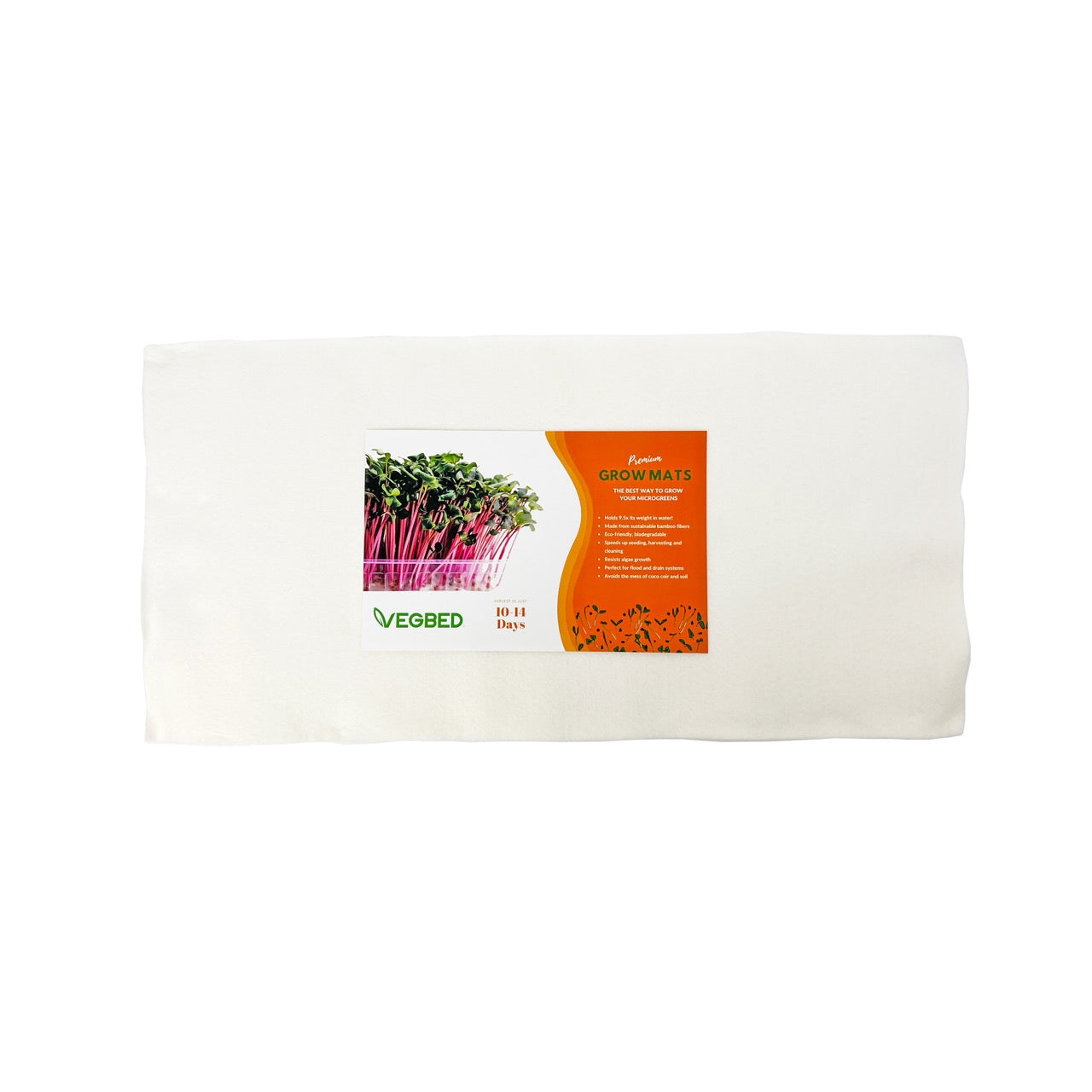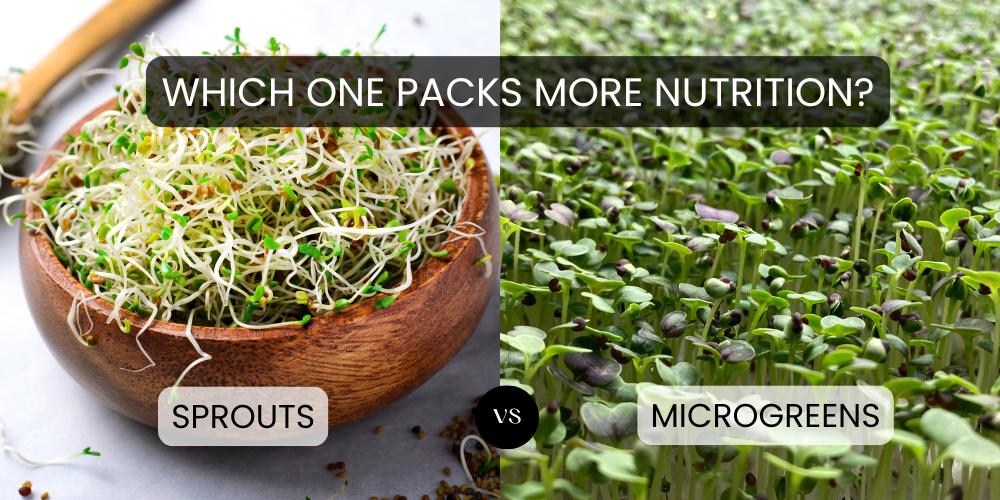When it comes to fresh, nutrient-dense greens, both sprouts, and microgreens have earned a reputation as superfoods.
But which one truly delivers the most nutrition? While they may look similar, these tiny greens have key differences in how they grow, their nutrient content, and how they’re used in cooking.
At Vegbed, we’re all about helping growers make informed choices. So, let’s break down the science behind sprouts and microgreens and determine which one delivers the most nutrition.
Understanding the Basics: Sprouts vs. Microgreens
Many people confuse sprouts with microgreens, but they are actually quite different in both their growth process and nutrient profiles.
If you’re still unclear on the key distinctions, check out our in-depth guide: Microgreens vs. Sprouts: What’s the Difference?
Sprouts
Sprouts are young germinated seeds that are typically grown in water, without soil or a growing medium. They are harvested within a few days, just as the first small leaves (cotyledons) emerge.
Because they are grown in a moist environment, sprouts require careful handling to prevent bacterial contamination.
🔹 Common sprout varieties: Alfalfa, mung beans, lentils, broccoli, radish
🔹 Growing time: 3–7 days
🔹 Growth medium: No soil or grow mats—only water
🔹 Consumption: Eaten whole, including roots and seed hull
Microgreens
Microgreens, on the other hand, are grown in soil or a hydroponic medium (such as our bamboo fiber grow mats) and harvested after the first set of true leaves appear.
They take longer to grow but develop a more intense flavor and a broader nutrient profile compared to sprouts.
🔹 Common microgreen varieties: Sunflower, pea shoots, basil, radish, kale
🔹 Growing time: 7–21 days
🔹 Growth medium: Soil or hydroponic mats
🔹 Consumption: Only the stems and leaves—roots are left behind
To get started with growing microgreens, read our step-by-step guide: How to Grow Microgreens Indoors: A Beginner’s Guide
Nutritional Breakdown: Which One is More Nutritious?
While both sprouts and microgreens are packed with nutrients, microgreens often contain significantly higher concentrations of vitamins, minerals, and antioxidants.
According to a study published in the Journal of Agricultural and Food Chemistry, microgreens contain up to 40 times more nutrients than their mature counterparts.
Key Nutrients in Sprouts & Microgreens:
|
Nutrient |
Sprouts |
Microgreens |
|
Vitamin C |
✅ High |
✅✅ Very High |
|
Vitamin K |
✅ Moderate |
✅✅✅ Extremely High |
|
Beta-Carotene (Vitamin A) |
✅ Moderate |
✅✅ High |
|
Antioxidants |
✅ High |
✅✅✅ Exceptionally High |
|
Fiber |
✅ Low |
✅✅ High |
|
Protein |
✅ Moderate |
✅✅✅ High |
Why Microgreens Win in Nutritional Density
🔹 More sunlight exposure: Unlike sprouts, microgreens undergo photosynthesis, which boosts chlorophyll and phytonutrient content.
🔹 Richer in fiber: Since microgreens grow longer and develop stems and leaves, they offer more fiber than sprouts.
🔹 Higher in antioxidants: Studies show that microgreens contain concentrated levels of polyphenols and flavonoids, which help fight inflammation and support heart health.
To explore more on the science of microgreens and their nutrient content, check out our blog: The Science Behind Microgreens: Understanding Their Nutritional Value.
Food Safety: Are Sprouts Riskier?
One major downside of sprouts is their higher risk of bacterial contamination. Since they grow in warm, humid conditions, they are prone to E. coli and Salmonella outbreaks.
Microgreens, grown in well-ventilated trays with Vegbed’s clean bamboo fiber mats, have a much lower contamination risk.
🔬 Winner: Microgreens are safer!
Practical Uses: When to Choose Sprouts vs. Microgreens
While microgreens may have the upper hand nutritionally, both have their own place in a healthy diet. Here’s when each one shines:
🔹 Choose sprouts if you want:
✔️ A quick-growing, raw food option for sandwiches, wraps, or smoothies
✔️ A mild flavor that blends well into meals
✔️ A high-protein snack with amino acids from the germinated seeds

🔹 Choose microgreens if you want:
✔️ A nutrient powerhouse with intense flavors
✔️ A more versatile garnish for gourmet dishes
✔️ A longer shelf life (microgreens can last 5–10 days, while sprouts last only a few days)

If you’re new to growing, check out our recommended varieties: Best Microgreen Varieties for Beginners: Easy, Fast-Growing, and Nutritious
The Verdict: Which One Should You Grow?
While both sprouts and microgreens have health benefits, microgreens take the lead in terms of overall nutrition, safety, and versatility.
They require a little more time and effort to grow but reward you with higher concentrations of essential nutrients.
At Vegbed, we provide high-quality bamboo fiber grow mats that make growing microgreens easier and more efficient—whether you're a home gardener or a commercial grower. If you're looking for an easy way to start, explore our eco-friendly microgreen grow mats today!
Which one do you prefer—sprouts or microgreens? Let us know in the comments!
Final Thoughts
Both sprouts and microgreens have their place in a healthy diet, but if you're looking for maximum nutrition, microgreens are the way to go. With their intense flavor and superior nutrient density, they can elevate both your meals and your health.
Ready to start growing your own? Check out our latest guides and expert tips on the Vegbed blog!
💬 Do you prefer sprouts or microgreens? Tell us in the comments!



